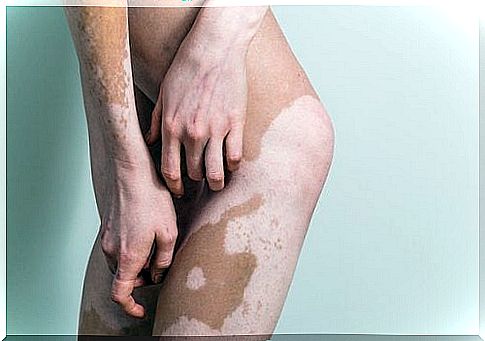What Is Vitiligo And What Are Its Causes And Treatment?

Have you ever wondered what vitiligo is? This chronic disease causes abnormal pigmentation of the skin. Its presence leads to the formation of white spots of different sizes distributed on different areas of the skin. They are generally found on the darker parts of the skin or in areas where friction occurs. The face, armpits, lips, genital area or hands are more prone to vitiligo.
The disease we are talking about affects 1-2% of the population. In general, vitiligo attacks people between the ages of 20 and 30 or over the age of 50. However, the condition can occur at any time of life and is more common among women.
Vitiligo is not contagious. Its appearance is unpredictable, but the disease tends to evolve. Strangely, some victims experience spontaneous repigmentation. These rare cases are most common in children.
What is vitiligo? What are its causes?
So far, scientists have tried to find out what vitiligo is, but have not discovered the causes of the condition. They believe it could be an autoimmune disease, but there is not enough evidence to confirm this theory. In addition, there may be a genetic cause. Statistics show that 1 in 5 people suffering from vitiligo has a relative with the same disease.
The hypothesis accepted by most specialists is that depigmentation occurs because melanocytes develop certain processes of self-destruction. There are other factors associated with this problem, such as sunburn and stress.
The level of depigmentation differs in each patient. Sometimes this process begins quickly, and then stops abruptly, which is why its cause cannot be guessed. In most cases, a clinical evolution takes place: the active periods of the disease alternate with periods of stagnation.
Symptoms caused by vitiligo
The main sign by which we recognize vitiligo is the presence of white spots on the skin. They appear mainly on areas exposed to the sun, but also on mucous membranes or regions where friction occurs.

The number of spots increases over time, but this is extremely unpredictable and differs from individual to individual. Obviously, the spots are more visible on darker skin. People with light skin notice spots only when they have reddened skin or a rash.
Even if the scalp does not appear to be affected by vitiligo, the hair may turn premature. In any case, this disease is considered benign because it does not cause major damage to the body. The main inconveniences are aesthetic and psychological.
Types of vitiligo
There are two types of vitiligo: non-fragmented (type A) and fragmented (type B). Type A is the most common and has a genetic cause. It has three subtypes, depending on the distribution of the depigmentation process.

- Located. The spots are few and are located in a specific area.
- Spots generally appear on the hands and around the orifices of the face.
- Depigmentation occurs on the hands and feet.
- Generalized. The distribution of spots is random and covers most of the body. This is the most common form of vitiligo.
Vitiligo type B is less common. It generally occurs in children and young people. Most of the time the spots appear and multiply quickly, but after about a year, the evolution slows down.
Diagnosis and prognosis
Normally, the doctor consults the patient and investigates the history of the disease to establish a diagnosis. This process includes a detailed analysis of the spots to see if they are caused by vitiligo. At the same time, the specialist asks questions about the family’s medical history and the general condition of the patient.
If in doubt or if symptoms may indicate the presence of other diseases, your doctor may perform other tests, such as:
- Skin biopsy
- UV lamp testing
- Blood Tests
- Ophthalmological consultation
What is vitiligo? Researchers are currently looking for a complete answer to this question, focusing on three important issues. First of all, specialists want to find out to what extent the stress or trauma suffered could influence the appearance of the disease. The second issue of interest is to establish the influence of genetic factors. The third mission is to perform experiments on guinea pigs to create new treatments.









